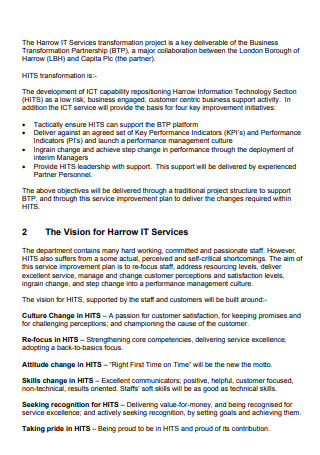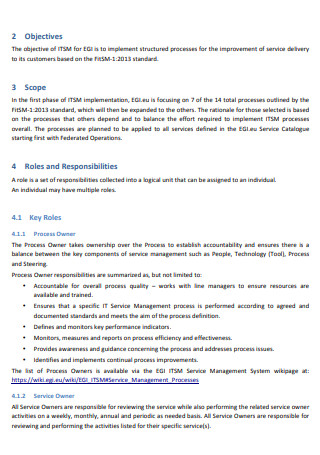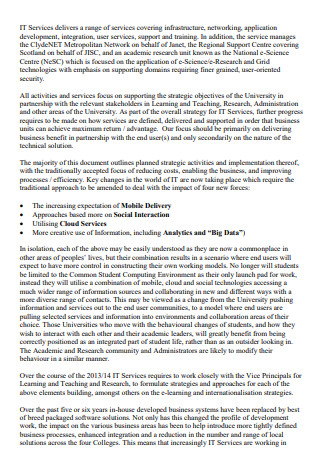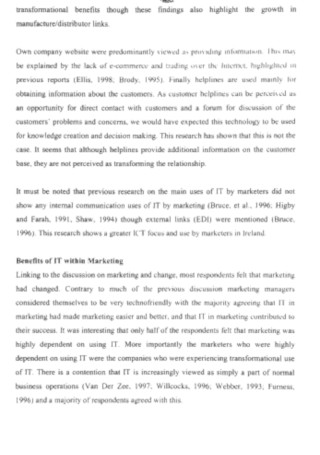4+ SAMPLE Free Sample IT Service Plan
FREE Free IT Service Plan s to Download
4+ SAMPLE Free Sample IT Service Plan
What is an IT Service Plan?
Key Processes of IT Service Management (ITSM)
Types of IT Services
How to Develop an IT Service Plan
FAQs
What is an IT support plan?
What are the five stages of the Information Technology Infrastructure Library (ITIL)?
What are the major processes of ITIL service strategy?
What is the main purpose of ITIL?
How to prepare a service plan for customers?
What is an IT Service Plan?
An IT service plan is a comprehensive technology action plan designed to offer business firms, institutions, and organizations the perfect IT solutions and access to professional support so that their systems are protected, costs are kept under control, and work performance is optimized. It is provided by software developers, computer system analysts, computer programmers, computer support specialists, and information security analysts to help companies have the appropriate technology in place for their organization, manage their asset and inventory investment to its best abilities, reduce network failures to prevent missed deadlines or production issues, and many others.
There are many types of frameworks for modern IT teams included in IT service plans: IT Service Management (ITSM), Information Technology Infrastructure Library (ITIL), and DevOps. ITSM is a systematic approach to service management and aligns IT services with business goals and service delivery standards based on budgets, resources, and results. ITIL aims at practices for coordinating IT services with business needs, helping organizations to adapt according to ongoing transformation and scale. On the other hand, DevOps is used to improve the collaboration between development IT operations teams and enables continuous development, integration, and automated delivery.
Key Processes of IT Service Management (ITSM)
IT Service Management (ITSM) is a system that guides IT teams in managing the implementation of IT services to customers. Aligned with Information Technology Infrastructure Library (ITIL) practices and influenced by DevOps concepts, ITSM is developed to improve the overall organization and to obtain efficiency and productivity gains.
Types of IT Services
Many IT services can greatly benefit various business firms and companies as they help their operations run smoothly. Here are some of the most common types of IT services:
How to Develop an IT Service Plan
Statista reported in 2020 that AI software has a market size of $34.9 billion and an annual growth rate of 41%, slated to reach $126 billion by 2025. If you are planning to improve your IT management system and incorporate AI software in your business, you need to develop a logical and systematic IT service plan. Consider the following steps so that you can easily create your IT service plan.
Step 1: Identify the IT Service Management Issues and Needs
Work with your IT service team and check the issues and needs of the management. Consider the severity of their problems and prioritize the service request types according to the needs of your business or organization. Use the same processes aforementioned in this article when you handle every service request type.
Step 2: Take a Proactive Approach to Problems
Manage the issues of your IT services by thinking proactively about them before they begin having an immense impact on your business operations. It is essential to monitor the incidents in your organization carefully and utilize key analytics data to obtain a bird’s eye perspective of service request types. Figure out and brainstorm how you want to manage the problems.
Step 3: Implement Change Management
Include in your IT service plan that you will carry out change management so that you can deal with more changes and your IT teams encounter new scheduling, coordination, and risk management issues. Search for effective change management platforms to help your business manage service requests fully well.
Step 4: Follow an ITIL Framework While Using a Sample IT Service Plan Template
If you are planning to take full advantage of your technology assets, you need to follow an ITIL framework to help you in supporting IT service request management functionality and use a sample IT service plan template. Choose your preferred plan template, customize it based on your needs and preferences, finalize your IT service plan, download the document, and print it right away.
FAQs
An IT support plan is a detailed plan that supports the interoperability and certification of an IT service while determining and documenting needs, infrastructure support, and IT interface requirements. It aims on solving the issues of IT programs and services.
The five stages of the Information Technology Infrastructure Library (ITIL) are service strategy, service design, service transition, service operation, and continual service improvement.
The major processes of ITIL service strategy are strategy management for IT services, service portfolio management, IT financial management, demand management, client management and tracking, and business relationship management.
The main purpose of ITIL is to provide businesses, institutions, and organizations with the proper tools to understand how processes within the information technology departments can be controlled and upgraded and to bring value to customers by developing these processes and managing costs, risks, and resources efficiently which includes using a resource management plan.
When you prepare a service plan for customers, evaluate the needs of your current customers and delve through the customer service processes. Assess the capabilities of your customer service and design an effective customer service strategy. After that, carry out your customer service action plan.
What is an IT support plan?
What are the five stages of the Information Technology Infrastructure Library (ITIL)?
What are the major processes of ITIL service strategy?
What is the main purpose of ITIL?
How to prepare a service plan for customers?
It is really challenging to run a business without technology as it may affect your business operations when technical problems suddenly occur. That’s why developing a clear, strategic, and well-detailed IT service plan helps your business or organization to ensure that your business avoids downtime and security risks and keeps your hardware and software running continuously and operating at peak efficiency. To fully guide you in the development of your IT service management plans, service transition plans, and service improvement plans, Sample.net offers a unique collection of well-designed PDF document templates such as a sample service improvement plan, an IT service agreement, and a scope of work for security services.





